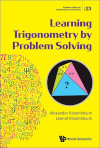- About MAA
- Membership
- MAA Publications
- Periodicals
- Blogs
- MAA Book Series
- MAA Press (an imprint of the AMS)
- MAA Notes
- MAA Reviews
- Mathematical Communication
- Information for Libraries
- Author Resources
- Advertise with MAA
- Meetings
- Competitions
- Programs
- Communities
- MAA Sections
- SIGMAA
- MAA Connect
- Students
- MAA Awards
- Awards Booklets
- Writing Awards
- Teaching Awards
- Service Awards
- Research Awards
- Lecture Awards
- Putnam Competition Individual and Team Winners
- D. E. Shaw Group AMC 8 Awards & Certificates
- Maryam Mirzakhani AMC 10 A Awards & Certificates
- Two Sigma AMC 10 B Awards & Certificates
- Jane Street AMC 12 A Awards & Certificates
- Akamai AMC 12 B Awards & Certificates
- High School Teachers
- News
You are here
Learning Trigonometry by Problem Solving

Publisher:
World Scientific
Publication Date:
2021
Number of Pages:
382
Format:
Hardcover
Price:
88.00
ISBN:
978-9811231209
Category:
Textbook
[Reviewed by , on ]
Peter Olszewski
10/30/2022
As mathematics educators, we know the overall goal of mathematics is to prove theorems. When students are first learning about a new concept in mathematics, there will be, more often than not, new definitions followed by properties and then examples. For students who are not mathematics major bound, the examples seen will most likely be numerical in nature. Depending on timing, there may not be room for applications, which is unfortunate. This text on trigonometry provides students and instructors with a different perspective on introducing traditional trigonometric concepts through applications.
The approach that A.L. Rozenblyum and L. Rozenblyum take is to motivate and provide context to the concepts and theory to make the learning process natural. The level of problems in the text span from standard trigonometric courses found in most high school and college level prerequisite courses for Calculus I. As presented in the Preface on pages vi – vii, there are also entertaining (Entertainment Problems) and cute problems presented that require no special knowledge. One such problem is the two books on a bookshelf and the bookworm.
The authors point out that every scientific theory is created to solve a certain range of problems. The opening example asks to measure the height of an apple tree. The concept of similarity is discussed, which then leads to the formula, \( H=(Dh)/d \). The problem moves forward to introduce the tangent of angle \( \theta \) to rewrite the formula as \( H = D \tan \theta \) with a conclusion discussing the sine and cosine functions. On page 43, a nice visual is presented to help students memorize the basic trigonometric functions of special functions using fingers and the formulas \( \sin(\theta)=\frac{\sqrt{n}}{2}=\frac{\sqrt{\mbox{Fingers below}}}{2} \) and \( \cos(\theta)=\frac{\sqrt{\mbox{Fingers below}}}{2} \). On page 100, the key ideas of when how to start a problem using the Law of Sines and Cosines is followed by the application of three friends, Alice, Bob, and Carol pitching tents and to find the angles between the tent positions.
There are some pure mathematical proofs presented in the text, which give the text a lot of diversity between applications. One particular problem is on page 177, shows that the expression \( a_{1} \sin(x) + a_{2} \cos(x) \) can be written as a single sinusoid. Using the sine sum formula, which is presented in Chapter 8, the expression can be written as:
\( a_{1} \sin(x) + a_{2}\cos(x)=\sqrt{a_{1}^{2}+a_{2}^{2}}\left( \sin(x) \cos(\phi) + \cos(x) \sin(\phi) \right) = \sqrt{a_{1}^{2}+a_{2}^{2}}\sin(x+\phi) \)
There are also problems that ask students to reason out a solution to obtain a formula as on pages 254-256, find the area \( S \) of the triangle given two sides and a bisector between them. The solution eventually leads to the nice resulting formula:
\( S=\frac{1}{2}ab \sin(2\theta)=\frac{lab(a+b)\sqrt{4a^{2}b^{2}-l^{2}(a+b)^{2}}}{4a^{2}b^{2}} \)
I definitely see this text being used in any trigonometry course to help students grasp the concepts of trigonometry through the use of applications. There is a wonderful diversity of applications, numerical problems, and proofs, which give the text a fruitful learning experience for any student. This well-written text should be on your list of possible texts for consideration.
Peter Olszewski is an Assistant Professor of Mathematics at Embry Riddle Aeronautical University in Daytona Beach Florida. His research fields are in mathematics education, effective study skills, and mathematical textbooks. He can be reached at olszewsp@erau.edu. Outside of teaching, he enjoys spending time with his loving wife Emily, playing golf, playing guitar and bass, traveling, and painting landscapes using oils.
See the publisher's website.
- Log in to post comments




